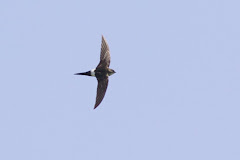
Back on my local patch in Denmark after a couple of weeks, the increase in the number of migrants was evident straight away with three Grasshopper Warblers singing along the track to Kongelunden, good numbers of Swifts motoring north overhead and displaying Whitethroats seemingly on every bush. On arrival at the point (at 0530am!) it was a stunning morning with virtually no wind and a beautiful clear blue sky.. A couple of Black-throated Divers flew east and a Garganey (see photo above) croaked its way around the lagoon. By the way, if there are any Garganey experts out there (you know who you are..!), I would be interested to know if the bird in the photo is a first summer male or an adult already starting to moult. It is clearly not a male in full summer plumage with a rather dull head pattern and lack of plumes on the flanks. But exactly what plumage it is, I am not sure. The wind started to pick up just a little from the east around 9am and it was then that I saw the first of 6 Honey Buzzards coming in off the sea. I like Honey Buzzards. Mostly for the fact that they are quite scarce in the UK so, when one sees one, it is rather special but also because they are one of the few things on this planet that eats wasps.. (or more accurately the grubs of wasps). A small group of Sanderling with a couple of Dunlin in tow meant I left Kongelunden with a new total of 134 species in Denmark. No Bullfinch yet.











